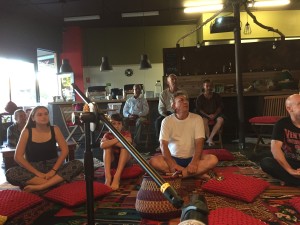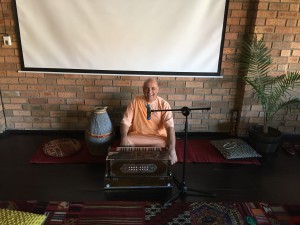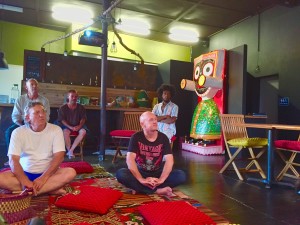07 Dec 2015 – Disappearance Day of Sri Narahari Sarakara Thakura
Varnāśrama is NATURAL, folks.
→ The Enquirer
The point Prabhupada made in the purport to 4.2.31 is that Varṇāśrama is natural. It happens automatically whether you recognize it or not. The system is already in place, we “implement” it by being sensitive to it.
For example, the Bhagavatam describes that the four ashramas are followed in different ways by the four varnas. Each varna takes brahmacarya in a different context and to a different extent, for example. We should “impliment Varnāśrama dharma” by realizing this! Not by expected everyone to do everything the same way.
An intellectual philosopher can be encouraged to certain lifestyles, but it is disastrous to encourage a manual laborer in the same way.
Varṇāśrama is not about imposing rules and structures on society, it’s about understanding what naturally exists in society and learning how to relate to it accordingly. Essentially, its about not treating everyone as if they were the same as everyone else, learning to be sensitive to individuality.
A person with brahminical leaning doesn’t really need to be told “you have brahminical leaning” unless their leaning isn’t all that strong in the first place. A person with brahminical leaning will already involve themselves in education, writing, science, and religion. So “implementing varṇāśrama” is not really about imposing a division of labor. It’s about recognizing the divisions of labor that arise naturally, and treating individuals accordingly.
Varṇāśrama already has potency to purify human consciousness. We don’t have to “pin a tail on a donkey” by tacking on a “Supreme Personality of Godhead” footnote for each varṇa – the Supreme Personality of Godhead is already in there, naturally. Pṛthu explains in Canto 4 chapter 21 that selfless, responsible duty to family and society is ITSELF purifying and spiritual and leads directly to serving Viṣṇu.
Brahmins, for example, serve Viṣṇu by by doing their service to family and society – teaching, studying, performing rituals, etc. It’s NATURALLY service to Viṣṇu to perform your social duties responsibly. Bhakti-yoga is even better, far better than Varṇāśrama, but remember we are talking about a social system for the masses, not just for people who want to be Krishna-bhaktas. So Varṇāśrama doesn’t have to be artificially forced to mimic Karma-miśra bhakti. The whole point of Varṇāśrama is to help the people who are not yet past the threshold for bhakti-yoga.
Vraja Kishor das
www.vrajakishor.com
Tagged: Varnashrama, Varnasrama
Dīkṣā Guru vs. Śikṣā Guru
→ The Enquirer
Question: Is this true, the diksa guru should be your most inspiring, enlightening siksa guru?
I wouldn’t say “should be.” I would say “could be.”
Saying “should be” hangs on to a conception that still belittles the true importance of Śikṣa guru. It’s saying something like, “The best śikṣā guru is promoted to a higher level, a real guru, a dīkṣā guru.”
I don’t see it like that. The śikṣā gurus are the “real” gurus, just like the dīkṣā-guru.
Question: But the idea is that one should ideally not accept diksa from a guru unless that guru’s siksha is prominent in their life, isn’t it?
Not necessarily.
The dīkṣā guru doesn’t have to give significant śikṣā. The dīkṣā guru simply has to accept a disciple into a family of spiritual practitioners and authorize the disciple to represent that family (by wearing its marks, for example, and bearing it’s last-names) and engage in its practices (particularly, it’s mantras).
So, what is important in a dīkṣā guru is (a) that they truly represent the values of the spiritual family, and (b) are accepted universally by that family as being authorized to accept new members.
Vraja Kishor das
Tagged: diksha guru, Guru, shiksha guru, siksa guru
HG Visvambhara Prabhu / SB 10.90.16-17
→ Kalachandji's Audio Archive
Drops of Water Wear the Stone
Giriraj Swami
 In a conversation in Toronto in June 1976, a guest asked Srila Prabhupada about his translation, and Prabhupada replied, “It can be finished, but I have to look after this management. That is the difficulty.”
In a conversation in Toronto in June 1976, a guest asked Srila Prabhupada about his translation, and Prabhupada replied, “It can be finished, but I have to look after this management. That is the difficulty.”
“I write in the night,” he explained. “I go to bed at half past ten, and I get up at half past twelve. Then I finish my chanting, if there is any balance, and then I begin dictating. And in the morning they take it and type it. So this Dictaphone is always with me, wherever I go, so my writing books is not stopped. Maybe [only a] few pages, but something is there daily. Little drops of water wear the stone. So in that way we have translated so many books. About fifty-four books are already published, besides the small booklets. Bhagavatam—about twenty-two volumes.”
Reading Srila Prabhupada’s words recently, I was struck by how hard Srila Prabhupada endeavored to give us his books, and I felt that we should reciprocate by studying them, distributing them, and discussing them, and also by writing—following his instructions and example, following in his footsteps.
—Giriraj Swami
Sunday Love Feast – Vedic Discourse by His Grace Uttam Anand Prabhu – December 6th,2015
→ ISKCON Brampton
His Grace Uttam Anand prabhu is a disciple of His Holiness Jayapataka Swami. Prabhu is in-house brahmachari at Toronto temple and always eager to preach any part of the GTA. Apart from his services to Toronto Temple, he spends his time conducting educational and training courses.
11:30 - 11:55 Aarti & Kirtan
11.55 - 12.00 Sri Nrsingadeva Prayers
12.00 - 1:00 Vedic discourse
1:00 - 1:30 Closing Kirtan
1.30 - 2.00 Sanctified Free Vegetarian Feast
Fasting.....................on Sun Dec 6,2015
Breakfast................. on Mon Dec 7,2015 b/w 7.37am-10.38am
Every fortnight, we observe Ekadasi, a day of prayer and meditation. On this day we fast (or simplify our meals and abstain from grains and beans), and spend extra time reading the scriptures and chanting the auspicious Hare Krishna mantra.

A Spiritual Extravaganza for your entire family Coming to Town on Dec 28.
Seating is limited!!
Please book your tickets with Nimai Nitai Pr(nikhil.pinki@gmail.com or 647.868.4675) or Amoghalila Pr(alokearora@hotmail.com or 647.521.4283) as soon as possible.
In honour of ISKCON Brampton's 10 year anniversary, please join us for an intimate holiday event, consisting of a spellbinding theatrical production by HH Bhaktimarga Swami, enchanting kirtan with internationally renowned kirtaneers Gauravani and Ananta Govinda prabhus & mesmerizing bharatanatyam by Komala Kumari . A wonderful way to spend the holiday Monday! No need to leave your children behind...separate children's activities to keep the younger attendees entertained too. A light vegetarian dinner and beverages will be served.
ONGOING EVERY SUNDAY
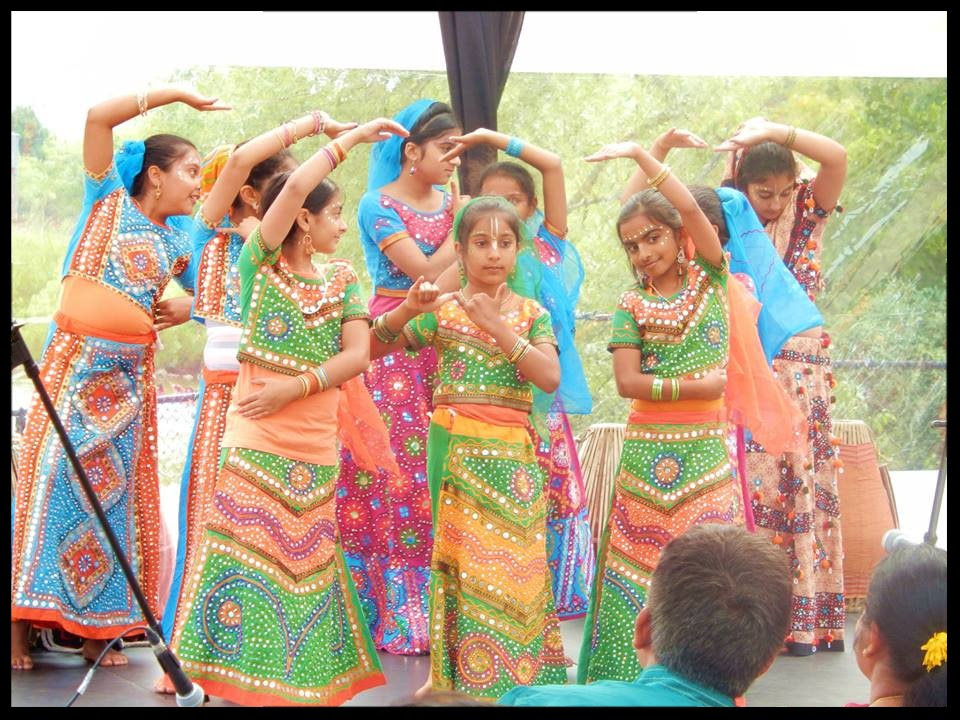 Sunday School
Sunday SchoolTo register,contact us
Email:sundayschool108@gmail.
Call:647.893.9363
The Sunday School provides fun filled strategies through the medium of music, drama, debates, quizzes and games that present Vedic Culture to children. However the syllabus is also designed to simultaneously teach them to always remember Krishna and never forget Him. School
The Sunday School follows the curriculum provided by the Bhaktivedanta College of Education and Culture (BCEC).
 Gift Shop
Gift ShopOur boutique is stocked with an excellent range of products, perfect for gifts or as souvenirs of your visit. It offers textiles, jewellery, incense, devotional articles, musical instruments, books, and CDs inspired by Indian culture.We're open on all Sundays and celebrations marked in our annual calendar.
Hare Rama Hare Rama Rama Rama Hare Hare
Chant and Be happy
Everyone should read!
→ KKSBlog
(Kadamba Kanana Swami, 16 April 2014, Durban, South Africa, Srimad Bhagavatam 1.7.34)
 One should not display anger in front of the deities; one should not cry in front of the deities or bring his mundane sorrow. When one cries tears of ecstasy – that is another matter. Caitanya Mahaprabhu used to cry litres of tears in front of Lord Jagannatha but we should not bring our mundane sorrows to Krsna; we should not do that; it is not our business to do that. That is according to pāñcarātrikī – rules which purify our behaviour. It means that one has to learn to act according to dharma. This is a very big step; a big commitment. It is about commitment and it is about desire. It can be done, when we desire. It can be done when we say, “Let me just desire to change.” It is due to ignorance that we do not desire. It is due to ignorance that we still chase after foolish desires; that we still chase after material enjoyment and sense gratification. That is due to ignorance. Therefore we need to cultivate transcendental knowledge and thoroughly read. Everyone should read! Sometimes, someone comes to me and says, “Ah, I never used to read.” It doesn’t matter, now read.
One should not display anger in front of the deities; one should not cry in front of the deities or bring his mundane sorrow. When one cries tears of ecstasy – that is another matter. Caitanya Mahaprabhu used to cry litres of tears in front of Lord Jagannatha but we should not bring our mundane sorrows to Krsna; we should not do that; it is not our business to do that. That is according to pāñcarātrikī – rules which purify our behaviour. It means that one has to learn to act according to dharma. This is a very big step; a big commitment. It is about commitment and it is about desire. It can be done, when we desire. It can be done when we say, “Let me just desire to change.” It is due to ignorance that we do not desire. It is due to ignorance that we still chase after foolish desires; that we still chase after material enjoyment and sense gratification. That is due to ignorance. Therefore we need to cultivate transcendental knowledge and thoroughly read. Everyone should read! Sometimes, someone comes to me and says, “Ah, I never used to read.” It doesn’t matter, now read.
Remember, Sri Caitanya Mahaprabhu glorifying that brahmana who was illiterate and who could not read but he received the order of his spiritual master and he would sit there everyday, faithfully reading the book, although he couldn’t read a letter! People would laugh but Sri Caitanya Mahaprabhu saw that he was crying and he asked him, “Why you are crying?” He said, “I am crying because when I see this drawing, this painting of Krsna, being the chariot driver or Arjuna, his devotee, the Supreme Lord becoming the chariot driver of his devotee. The Lord as the servant of his devotee, that makes me cry!” Lord Caitanya said, “You are the greatest expert of the Gita.”
Bhakti Tree preaching
→ Ramai Swami
Positive Thinking 9 – D of IDEA – Divinity underlies the universes order
→ The Spiritual Scientist
Podcast
Download by “right-click and save content”
The post Positive Thinking 9 – D of IDEA – Divinity underlies the universes order appeared first on The Spiritual Scientist.
Kurma Dasa: An Absolute Beauty!
Janelle from Nambour asked…
→ Dandavats

Kurma Dasa: An Absolute Beauty!
Janelle from Nambour asked about a good Christmas fruit cake. Here is an absolute beauty, published in my very first cookbook ‘Great Vegetarian Dishes’. It was originally given to me by Hari Bhakti Dasi who got it from her mother. Try it - you won’t be disappointed.
This traditional fruitcake is ideal for weddings, birthdays, or any special occasion requiring a luscious, rich cake. It can be kept for several weeks after baking.
Read the entire article here: http://goo.gl/7F7jfd
Timings of the Four Yugas: The Shastric Evidence
→ Dandavats
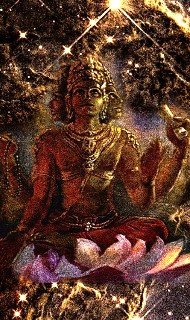 By Sri Nandanandana dasa
By Sri Nandanandana dasa When describing the length of the yugas or ages, and which yuga we are in and how far along we are in it, there is sometimes confusion about how to calculate them. Some people think we are already in the next Satya-yuga, known as the Golden Age. The problem is when the yugas are figured only according to the years in earth’s time, in which case any calculations will never be accurate. They are described in the Vedic literature according to the celestial years, or years of the devas, not according to the time we experience here on earth. This is where we have to make adjustments. Nonetheless, there are specific references in the Vedic texts which make it clear how to calculate them. For starters, the Mahabharata (Shanti Parva, 231.12-20) explains it in detail: “The rishis, measuring time, have given particular names to particular portions [of time]. Five and ten winks of the eye make what is called a Kastha. Thirty Kasthas make what is called a Kala. Thirty Kalas, with the tenth part of a Kala, make a Muhurta. Thirty Muhurtas make one day and night.. Continue reading "Timings of the Four Yugas: The Shastric Evidence
→ Dandavats"
Beautiful Mayapur! Beautiful Kalna, West Bengal (8 min video)…
→ Dandavats

Beautiful Mayapur! Beautiful Kalna, West Bengal (8 min video) (Ambika Kalna or simply Kalna is a town, a municipality and headquarters of Kalna subdivision in Bardhaman District in the Indian state of West Bengal. It is situated on the western bank of the Bhāgirathi.)
Watch it here: https://goo.gl/kA8xvO
Life Beyond Borders – Radhanath Swami (1hr Keynote speech -…
→ Dandavats

Life Beyond Borders - Radhanath Swami (1hr Keynote speech - video)
Martin Pollard, a postgraduate journalism student, said “The moment he stepped onto the stage, his energy was infectious. He changes the room just by his presence and I was inspired how conscientiously he answered my questions.” Martin added “I get quite nervous seeing men of the cloth and I’m definitely in the non-religious camp, but the principles he spoke of, I could relate to. He was just a really compassionate, wise man to be honest!”
Watch it here: https://goo.gl/q857HD
A new biography of ISKCON Founder-Acharya Srila Prabhupada,…
→ Dandavats

A new biography of ISKCON Founder-Acharya Srila Prabhupada, entitled “Swami in a Strange Land: How Krishna Came to the West” is set to be released on May 3rd 2016, during ISKCON’s 50th anniversary year.
While there is already an exhaustive biography of Prabhupada in the form of Satsvarupa Das Goswami’s multi-volume Srila Prabhupada Lilamrita, as well as many individual memoirs, author Yogesvara Das (Joshua M. Greene) felt the need for a single volume bio that would be accessible and marketed to a broad general audience.
Read the entire article here: http://goo.gl/qeftpW
Preaching program at Conscious Leadership Conference at the Bombay Stock Exchange
→ Dandavats


Click above to see the complete gallery
On November 21, 2015, over 400 industrialists, SME entrepreneurs, investors and corporate leaders converged at the International Convention Centre of the Bombay Stock Exchange in Mumbai for a conference on “Conscious Leadership” organized by the Artha Forum, (a community dedicated to providing healthy work-life balance and holistic world view to entrepreneurs, business and thought leaders) in partnership with the BSE, TiE Mumbai & the Indo American Chamber of Commerce. Radhanath Swami was invited to give the Keynote Speech. Eminent figures from corporate India, government officials and industry regulators shared the dias including Mr. Ronnie Screwvala, Founder – UTV & Swades Foundation, Mr. N. N. Kumar, Chief Commissioner of Income Tax, Mr. Ashishkumar Chauhan, MD & CEO – BSE, Mr. Sunil Shaghai, MD & Head of Banking – HSBC India, Dr. N. D. Desai, Chairman – Apar Group & Mr. Hrishikesh Mafatlal, Chairman – Arvind Mafatlal Group.
Mr. Ashishkumar Chauhan spoke of how businesses need to be not only ‘compliant legally’, but ethically and legally right as well. Guests shared their joyful responses of his analysis of the internal push-pull dynamics of a typical player in the market riding the wave of an ocean of opportunities. Mr. Chauhan exclaimed that, of the over 200 conferences that are conducted in this conventional hall, this one was the one with a difference.
Sharing his experiences in business, Mr. Ronnie Screwvala emphasized on concept of giving back to society and how he introduced this culture in early days of his organization. Mr. Screwvala explained how he evolved from making movies to adopting villages and making a difference is in the lives of millions.
Radhanath Swami shared the message that it is imperative in business to earn with integrity and spend with compassion. He said that as a child raised in United States he saw so much wealth and luxury. “But all these technologies, power and road systems, seemed so shallow to so many people in my generation. Because greed can never satisfy the heart.”
He further explained that poverty in society is simply an extension of the inner poverty of the human heart. “When there is a poverty of compassion, poverty in society manifest, and when there is wealth within the hearts our leaders, there is prosperity emotionally, physically and spiritually,” he said.
Radhanath Swami cited the example of Yankees baseball Manager Joe Torre. Under his leadership, the Yankees were the most successful team ever winning many titles. But none of this fame and honor were particularly meaningful to him. Due to his difficult childhood and the abuses from his alcoholic father, he would go out and hit the ball hard to take his stress out. But after he retired he started working with ghetto schools to help children from abusive homes. Radhanath Swami quoted Mr. Torre as saying, “When I see those children who went through what I went through – lost confused and alone, and then I see them smile and I see that they feel loved, that is meaningful. Not the money, not the awards.”
Radhanath Swami concluded his talk with the message that if we understand that our wealth, our beauty and our influence belongs to the Lord, and we are just care takers, we will naturally use it in a principle of seva (service). “It’s the leadership the world needs.”
Temple of Vedic Planetarium update. (Album with photos)…
→ Dandavats

Temple of Vedic Planetarium update. (Album with photos)
Sadbhuja Das: In this recent time we have been concentrating on the interior and exterior finishing work on the TOVP. A lot of progress was made just in the past weeks.
With no time to wait, the sandstone has arrived from Rajastan and already we have begun applying the Jali windows as you can see in the attached images.
This Pink Sandstone will frame the windows of the 2 base floors of the Planetarium and Nrshimha Dev wings.
We will keep you updated every week or so on this progress.
Find them here: https://goo.gl/1abfpW
The mission of our guardian angels
→ SivaramaSwami.com
The post The mission of our guardian angels appeared first on SivaramaSwami.com.
Daily Darshan : December 4th, 2015
→ Mayapur.com
The post Daily Darshan : December 4th, 2015 appeared first on Mayapur.com.
ISKCON Auckland New Zealand : Today’s Rathayatra, Thursday…
→ Dandavats

ISKCON Auckland New Zealand : Today’s Rathayatra, Thursday 3rd Dec. (Album with photos)
Srila Prabhupada: Chanting the holy name is the chief means of attaining love of Godhead. This chanting or devotional service does not depend on any paraphernalia, nor on ones having taken birth in a good family. By humility and meekness one attracts the attention of Krishna. That is the verdict of all the Vedas. (Caitanya-caritamrta, Antya-lila, 4.71 purport)
Find them here: https://goo.gl/hsdlpf
Second Jagannath Ratha Yatra in Bandung, Indonesia
→ Dandavats


(Click above for the whole album of photos)
By Hari Narayana das
“The Ray of Peace”
Second Jagannath Ratha Yatra in Bandung, Indonesia
Bandung is a small island in Indonesia. The annual ‘Light Festival’ commemorates the anniversary of Bandung city. This year the festival fell on the 8th of November. The festival includes a parade throughout the island with a variety of acts and performances. Many departments under Bandung’s Government participated. Taking advantage of this golden opportunity, devotees organized a grand Ratha Yatra festival and joined the parade. They were granted permission from the Government. Srila Prabhupada was always pushing forward this festival. “I am so much satisfied with your successful performance of Ratha-yatra festival and I am awaiting to see similar festivals in all our other center.” (Letter to Gurudasa, 16th July 1968)
The theme of the festival this year was ‘Animalia’. All participants were requested to decorate their cars with a variety of animals. It seemed that the Lord was helping out, as the Ratha was already bedecked with two elegant white horses. Adorned with colorful flowers and electric lamps the chariot was attracting all who glanced upon it.
Devotees from all parts of Indonesia flew in to be present for the festival. Some had been saving up for months in order to attend this program. “I am so glad to learn that you are prepared to work even harder, as a forward soldier, to fight the maya. May Krsna give you more and more strength.” (Letter to Tamala Krsna, 18th March 1969)
Devotees arrived the day before the festival. All their needs, such as prasadam and accommodation were taken care by local devotee, Lokanath Acarya das. A teacher training center was hired where devotees could take rest and prepare for the festival. The deities of Jagannath, Baladeva, and Subadra devi arrived after a long journey from Jogjakarta and spent the night with Their’ devotees in the teacher training center. Shortly after, the chariot also arrived from Jakarta. The chariot team worked late into the night, assembling the cart in preparation for tomorrow’s procession. Many matajis also stayed up late preparing flower garlands for the Lord.
Srila Prabhupada stressed on our sadhana as a first priority. “And never neglect to chant your sixteen rounds of beads daily, rise early without fail, attend mangala-arati take bath, and follow the other regulative principles, and everything will come out very successfully, you can rest assured of that.” (Letter to Bhargava, June 13th 1972) Following this instruction, the next day devotees woke up early, finished their rounds and attended mangala-arati. At 7am, the Lord gave darshan in a spectacular new dress. An ecstatic kirtan led by local devotees set everyone in the right mood for the festival. Before the parade started, a group of devotees distributed books and leaflets requesting all to attend.
The Ratha Yatra officially started at 2pm. Devotees gathered in the hall where the Ratha Yatra Committee welcomed all and expressed gratitude for their participation in this festival. Senior devotees gave short speeches about Lord Jagannath headed by Agastya Muni das. Adi Purusa das, chief committee member of ISKCON 50 in Indonesia also spoke. He then informed the devotees about the day’s schedule. A recorded class by HH Subhag Swami Maharaj was played and translated by Sudarananda das. Maharaj sent his well wishes to the devotees who worked hard in order for the festival to take place. He mentioned that Srila Prabhupada wanted that all devotees should work together, tolerate and cooperate. Maharaj was extremely joyful when he heard that so many devotees came from all over Indonesia to attend the festival becoming united as one big family.
Conch shells were blown as the Lord made His way to the chariot, thus creating an auspicious atmosphere. The demigods sent their blessings in the form of rain as Jagannath was on route to the chariot! As the chariot was pulled was to the Government Office, the starting point of the parade, the rain got heavier and heavier. However, melodious kirtan led by Sridhar das lifted not only the devotee’s spirits, but also others who were participating in the Light Festival parade and in a short time everyone was on their feet dancing. “If there is chanting of Hare Krsna, even if the soul is there for a short time. Oh! He will hear and become advanced. This sound vibration is not material, it is spiritual and powerful beyond our conception. So it cannot be hindered in any way by something material; it surpasses all these material barriers”. (Letter to Mukunda and Janaki, 28th February 1968)
The parade started and the Lord’s chariot was pulled. It was amazing to see that after the chariot set out it stopped raining! The sky cleared up and the stars shone as bright as ever. Jagannath made His route from Diponegoro Street-Trunojoyo Street- Sultan Agung Street- Ir.H.Juanda Street- Merdeka Street- Lembong Street-Tamblong Street and finished in Asia Africa Street. Along the way, many passersby joined the devotees chanting and dancing. Premadhana das captivated all with his soothing voice. A ton of oranges, kindly donated by Dinadarini dasi was distributed liberally to all. A few of Srila Prabhupada’s sankirtan warriors distributed books along the way, spreading the message of Jagannath to all.
The Light Festival came to a close when it reached Asia Africa Street. All the guests of honor made their way to the stage. Last but not least to make His way onto the stage was Jagannath, the real guest of honor! As the Lord made His way up, many looked on with great wonder and delight. An enactment of Rasa Lila was performed by devotees on stage with the audience highly appreciated the act. Agastya Muni das and Adi Purusa das garlanded Mr. Ridwan Kamil, the Mayor of Bandung, with a flower garland offered to the Lord and presented him with a copy of Bhagavad Gita. Mahaprasadam was then distributed to all. The festival was covered by the national television and newspaper, thus thousands took darshan of the Lord who is known as Patita Pavana (Savior of the fallen). The Ratha was voted third place in the category of the best decorated car.
We hope that Srila Prabhupada is pleased with our humble efforts. We take great inspiration from a letter he wrote which is of relevance to us. “I thank you all very much for making the Ratha-yatra festival so successful. Please convey my gratitude to all the boys and girls who participated in this great transcendental service. This is the second year, and you have made a great stride from the first year and in the third year, I hope it will be still more successful.” (Letter to Upendra, 4th July 1968)
We offer our respects to HH Kavicandra Swami and HH Ramai Swami, (the GBCs of Indonesia) for their support and guidance to always look for new avenues for sankirtan in Indonesia. Our humble obeisances to HH Subhag Swami for his inspiration and always reminding us of the importance of Mahaprabhu’s sankirtan movement. Our gratitude to the SAKKHI leaders and all the devotees who participated. Special thanks to the Jogjakarta devotees for bringing Their Lordships from Jogjakarta to Bandung. The prasadam team who worked throughout the night and cooked a variety of items for the Lords and his devotees deserve special mention, as well as the kirtan team who attracted all by their melodious voices and sweet playing of instruments.
We thank Srila Prabhupada again and again for showering his unlimited mercy upon us and keeping us engaged in the sankirtan movement of Sri Caitanya Mahaprabhu.
Jay Jagannath, Baladeva, and Subadra Devi ki…. Jay!
December 4. ISKCON 50 – S.Prabhupada Daily…
→ Dandavats

December 4. ISKCON 50 – S.Prabhupada Daily Meditations.
Prabhupada Idioms: The dictionary defines an idiom as “a style or form of expression that is characteristic of an individual.” One has to know how Prabhupada used idioms by listening to his lectures, or by being present for his talks. Each of these phrases can open up a whole world of Prabhupada realization.
“Where is the difficulty?”
Prabhupada said this after explaining how easy and accessible Krishna consciousness is. Anyone can offer Krishna a fruit, a flower, or some water. Even a child can take part in the chanting – “Where is the difficulty?” Just as we were born from our father, so our father had a father, and his father had a father; if you go back ultimately, you will find there is an original father who is the source of everyone. In this way we can understand that Krishna is the seed-giving father – where is the difficulty to understand this?
By this expression, Prabhupada encouraged us to come forward and not make excuses. If we take to Krsna consciousness, we will not find it difficult. Prabhupada used the phase as a challenge to those who believe that spiritual life is too problematic. Prabhupada untangled the problems with logic and sastra, and then interjected this challenge.
Read the entire article here: http://www.dandavats.com/?p=20490&page=3
Does the presence of the Gayatri in the Bhagavatam mean that it should be studied only by the brahmanas?
→ The Spiritual Scientist
How is the Bhagavatam’s first verse correlated with the Gayatri mantra?
→ The Spiritual Scientist
Why does the Bhagavatam repeatedly refer to Vasudeva instead of Krishna?
→ The Spiritual Scientist
07 Dec 2015 – Utpanna Ekadashi
→ ISKCON Desire Tree Event Reminder
28.11.2015 H.G.Prabha Vishnu Prabhu_SB-06.03.1
→ Gouranga TV - The Hare Krishna video collection
28.11.2015 H.G.Prabha Vishnu Prabhu_SB-06.03.1
ISKCON 50 Meditations: December 4, 2015
→ ISKCON News
HG Dhirodatta Prabhu / SB 10.90.15
→ Kalachandji's Audio Archive
Ode to a soul
→ Servant of the Servant
Body and soul there are two,
The body is only a dress, if you think its you then life's a mess,
Dog, elephant, lion, rat, flower, spider, duck and rat...
the same kind of soul is in each one, happy and bright like a sun!
- Poem written by my 10 year old nephew
Hare Krishna
Goodbye Vrindavan!
→ travelingmonk.com
A state of emergency
→ KKSBlog
(Kadamba Kanana Swami, 16 April 2014, Durban, South Africa, Srimad Bhagavatam 1.7.34)
 Our strength is not brahman-tejas (brahminical power). Our strength is to carry the mercy of Sri Caintanya Mahaprabhu. That is our strength. Our strength is to, somehow or the other, chant Hare Krsna and induce others to chant Hare Krsna. To become great qualified brahmanas is not so easy. Srila Prabhupada describes in his purports to the first canto of Srimad Bhagavatam that it is an emergency in this age of kali. Therefore for the sake of emergency, we give positions to people although they are not really qualified; we give them positions of brahmanas, we give them positions of sannyasis. Prabhupada said we do this because we need leaders in society. We need leaders! But what is their qualification?
Our strength is not brahman-tejas (brahminical power). Our strength is to carry the mercy of Sri Caintanya Mahaprabhu. That is our strength. Our strength is to, somehow or the other, chant Hare Krsna and induce others to chant Hare Krsna. To become great qualified brahmanas is not so easy. Srila Prabhupada describes in his purports to the first canto of Srimad Bhagavatam that it is an emergency in this age of kali. Therefore for the sake of emergency, we give positions to people although they are not really qualified; we give them positions of brahmanas, we give them positions of sannyasis. Prabhupada said we do this because we need leaders in society. We need leaders! But what is their qualification?
So, this is something to take upon our head: Our acute lack of qualification and the urgency to become more qualified. We have just been given these positions out of emergency and that for once in our life, we should begin to embrace the principles very seriously and not only four regulative principles but also the principles of vaisnava behaviour and so on. Because that is a brahmana; brahmana means principled life and that is a great challenge for us because it means that we have to change. So Krsna consciousness means a great commitment to change and we are given the systems by which we can change.
Positive Thinking 8 – I of IDEA – Understanding our identity boosts our positivity
→ The Spiritual Scientist
Podcast
Download by “right-click and save content”
The post Positive Thinking 8 – I of IDEA – Understanding our identity boosts our positivity appeared first on The Spiritual Scientist.
New Photos Released: ISKCON Leaders Meet Indian PM Modi and UK PM David Cameron
→ ISKCON News
New Srila Prabhupada Biography Comes for ISKCON’s 50th
→ ISKCON News

While there is already an exhaustive biography of Prabhupada in the form of Satsvarupa Das Goswami’s multi-volume Srila Prabhupada Lilamrita, as well as many individual memoirs, author Yogesvara Das (Joshua M. Greene) felt the need for a single volume bio that would be accessible and marketed to a broad general audience.
ISKCON Prison Ministry – Petersburg Krishna Kirtan Concert
→ Dandavats

ABOVE: front row, third from the left; Krishna Kirtan, Sarva-drik, Sudevi, Phalini, and Haripada prabhus
Petersburg Krishna Kirtan Concert
By Phalini Devi Dasi
At 7:00 a.m. on August 22, 2015, my husband and I climbed into the car with Sarva-drik dasa and his wife Sudevi. We all drove to the Petersburg (Virginia) Federal Correctional Complex where we all had gone for a kirtan and preaching program in September of 2014. Our first trip there had been such a positive experience that we were eager to go again.
During the pleasantly scenic drive between Sandy Ridge and Petersburg, we learned that before relocating to Prabhupada Village six years before, Sarva-drik Prabhu had lived at the Denver ISKCON Temple for twenty-five years. While living there, he used to regularly go to the prison in Englewood, Colorado to chant, preach and teach the inmates about Krsna Consciousness, as well as to distribute prasadam. He now works in connection with the ISKCON Prison Ministry. Over the last six years, he developped and now follows a regular prison preaching route. Prison preaching has given Sarva-drik Prabhu such a sweet taste that he goes to at least five prisons every month—one or two per weekend—including facilities in South Carolina, North Carolina and Virginia.
We arrived in Petersburg right on time, with our closed-toe shoes (visitors are not allowed to wear flip-flops there) and our otherwise completely devotional dress, tilaka and musical instruments. After clearing security, we were escorted to the chapel. The Prison Chaplain and Bhakta Richard (aka “Krishna Kirtan”–the devotee who is in charge of the Bhakti-Yoga Club at the medium-security facility) met us there and led us into a large room which is part of the vast prison chapel complex.
We were not prepared for what awaited us. Forty men greeted us, many of whom were positioned and ready to play various types of musical instruments to accompany the kirtan. We recognized some of the faces and gave nods and smiles of recognition to those whom we had met the previous year—Simon, Louis, and David were a few of the names we remembered.
Bhakta David, the now-famous origami florist, had handmade many more paper flowers this year than he had the previous year (Petersburg Correction Facility still does not allow real flowers on campus). In fact, he had made more than two-hundred paper flowers, dozens of which were strung together as garlands. As we entered the concert hall, we were lovingly garlanded by four of the men. Bhakta David had also learned how to make multi-colored origami lotus flowers, which were beautifully arranged in vases on the altar. Their Lordships Sri Sri Gaura-Nitai, dressed in simple yet lovely outfits, graced the altar with Their effulgent, benevolent forms and were accompanied by an attractive statue of Sri-Sri Radha-Krishna as well as a set of blissful Jagannatha deities. Bhakta Louis, Krishna Kirtan’s cell-mate, is particularly attracted to Lord Jagannatha, so he always makes sure that Jagannatha, Baladeva and Subhadra are prominently placed on the altar and a huge three-foot wall-hanging of Lord Jagannatha’s face is hung on the wall behind the altar.
We were happy to see the familiar Prabhupada Pastimes video playing on a screen to the right of the altar. It always fills our hearts with joy and makes us smile to see old clips of Srila Prabhupada and his disciples from the sixties and seventies.
Krishna Kirtan Prabhu signaled for the kirtan to start. We were amazed by how all the men sang Hare Krishna so enthusiastically and played their instruments so expertly together. I was especially impressed that all the instruments were in tune with each other and even with our harmonium! The kirtan sounded so sweet that I found myself hoping that someone was recording it. Bhakta Simon played the congas and there were even a bass guitar and another harmonium playing along. It was phenomenal. A veritable Petersburg Krishna Kirtan Concert!
After the kirtan, both my husband and Sarva-drik Prabhu took turns speaking. Haripada Prabhu reminded the men that there are 8,400,000 species of life and that the human form of life is very rare. He said that we are all lucky to be in human bodies because we have the opportunity to reconnect with Krishna, God. He said that God is known as Yogeshvara—the master of all mystic powers—and that each of us has some powers, but God has all powers—all potencies—to the fullest degree. Krishna can be compared to the unfathomable ocean, and we can be compared to small quantities of ocean water. If you take a drop of ocean water or dip a bucket into the ocean, you’ll find salt just like in the vast ocean, but in a small quantity. So we are like Krishna, in that we have a small, minute quantity of powers compared to His unlimited powers.
Recalling for the men the Bible story of the prodigal son, Haripada Prabhu painted a mental picture for them, “Imagine a wealthy family. One of the children leaves home and becomes a drunkard. The family tries to encourage him to come back, but he refuses. But some day he may decide to reconnect with his father, with his family. We are like that prodigal child. We have the wealthiest, most loving father, yet because of our minute independence, we have somehow chosen to leave home, to disconnect from our family and to try to enjoy this material world in a separate way. As in the story of the prodigal son, when we decide to return home to Lord Krishna, we are welcomed with open arms and unconditional love.”
Sarva-drik Prabhu spoke about Canakya Pandita’s verse in Niti-sastra which explains that time is the most valuable asset for the human being. He emphasized that we cannot buy back even a moment of time, even with unlimited money. He questioned the men, “How do you invest your time, your most valuable asset? Do you spend time contemplating ‘who am I’?” Then he took that thought further by asking, “If you don’t know who you are, how can you be happy?” He asked, “You have all lost your families, your cars, your bank accounts, and your reputations. How can you be happy without these things?” Then he proceeded to explain how to be happy without material attachments and affluences. He advised, “Meditate on who you really are, and what is your relationship with God. Ask yourself, ‘Why do I have to be sick and grow old and die?” Sarva Prabhu told the men that only a fortunate person feels inspired to ask these questions. He concluded by urging the men to become fortunate, and to learn to use the wealth of their time wisely. “If you misuse wealth, all you have left is sorrow, but if you use your time efficiently to understand what is the soul’s relationship with God, you can become happy. That is the actual object of human life, the real wealth of human life.”
After the devotees spoke, we all joined together in another sweet, melodious kirtan. Although we sang a melody that the inmates had not heard before, they caught on quickly and soon became absorbed in the sound of the holy names. We noticed many of the men closing their eyes and really trying to hear the holy names. Some even accompanied us with their musical instruments. By Sri Nama Prabhu’s mercy, we all felt purified and uplifted by the beautiful kirtan of Krishna’s holy names.
Following the kirtan, Haripada Prabhu spoke again. “The Vedas tell us that God created two realms, the material realm and the spiritual realm. Both realms originate from Krishna. When we come to the human form of life, Krishna grants us the freedom to choose whether to reside in the spiritual realm or the material realm. In the human form of life, we have the chance to read transcendental literatures which describe both realms. We also have the chance to decide in which realm we want to reside.” He illustrated a scenario: “Someone may find himself in a bad neighborhood, a dangerous neighborhood. He may then choose to move to a better neighborhood. The human form of life allows us the chance to choose to move to a better neighborhood, the spiritual world. So how does one go about moving to that better neighborhood of the spiritual world? The method for transferring ourselves to the spiritual world is given by Lord Caitanya in this Age of Kali—the chanting of the holy names of the Lord.” He compared the chanting of Hare Krishna to a spiritual alarm clock. “This chanting is a sound vibration that wakes us up from the dream of identifying with our body and everything connected to our body. The chanting is a sound vibration that wakes us up so that we can realize who we are. Lord Caitanya, Krishna Himself, came five-hundred years ago to give us this process of mantra-meditation. The chanting of Hare Krishna wakes us up so we can understand our eternal relationship with Krishna.”
Because the Petersburg Facility does not allow prasadam distribution, the inmates bought candies and after offering them to Sri Sri Gaura-Nitai, happily distributed them to all.
Many of the men had requested to have their pictures taken with us. Unfortunately, the photographer arrived late, so many participants had already left before the camera was able to capture them. After much picture-taking with those who were still present, we said our good-byes, feeling very grateful to Lord Caitanya and the Guru-parampara for engaging us in prison preaching.
On the drive home to North Carolina, my husband and I expressed our gratitude to Sarva-drik Prabhu for his years of hard work, traveling to prisons and sharing Krishna consciousness with inmates who might otherwise never get a chance to hear the kirtan of Krishna’s holy names or Krishna conscious philosophy. We thanked him for encouraging us to come along and experience the nectar that is freely and readily available to those who are willing to take the time and effort to touch prisoners’ lives with Lord Caitanya’s mercy.
***
This article is just a small part of the bi-monthly IPM NEWS, an electronic newsletter. To read the whole Nov/Dec 2015 issue, please go to: http://iskconprisonministry.us/node/473
If you wish to receive it in your mailbox, simply email me at iskconprisonministry@gmail.com with “SUBSCRIBE” in the subject line.
You can also view more excerpts of inmate letters and also their artwork on our website: www.iskconprisonministry.org
You want to help?
OUR PRESSING NEED OF THE MOMENT: One of our donors who, for many years (thank you!), sponsored all the shipping of boxes of books to chapel libraries will be unable to do so for an indefinite time. Without this donation, I am unable to send books to chapel libraries.
This is vital, as hundreds of inmates have access, for years on end, to the material placed in libraries. Please help!
The yearly cost is $2,000 a year (or $500 every trimester/ or $167 a month).
If you can help, please contact Mukunda Dasa or Bhakti-lata Dasi at:
iskconprisonministry@gmail.com
ISKCON Prison Ministry
3759 McCreary’s Ridge Road
NBU #46
Moundsville, WV 26041
Visiting the Ashram
→ The Vaishnava Voice
For some years I have had a collection of books from a variety of religious traditions. I also have a few from the community I was brought up in, the Methodist Church. One book – one amongst many – is this volume, by one John J. Vincent.
As life and fate arrange it, I went to Sheffield last week and was introduced to the author himself. The Ashram Community Trust is a Christian organisation in Sheffield, Yorkshire which was founded in 1965. The group runs many welfare, educational, and health food projects in the city. Its founder, the Reverend Dr. John Vincent, former head of the Methodist Conference, has made a lifetime study of the theology of discipleship according to the Bible. He is also a doctoral advisor on a PhD course run by the Urban Theology Unit, also founded by him.
He has been quite prolific in his writing and tireless in his community building through the years. Now in his eighth decade – but still going out for a morning run – he continues to help others with his depth of wisdom and experience. On a visit to Sheffield I presented him with a copy of my The Guru & Disciple Book which he said he would read with great interest.
A note to all: Please visit Mt Everest immediately before the…
→ Dandavats

A note to all: Please visit Mt Everest immediately before the mountain expires! :-)
A visit to Vrindavana (Album with photos)
Indradyumna Swami:…
→ Dandavats

A visit to Vrindavana (Album with photos)
Indradyumna Swami: Goodbye Vrindavan! This morning I went on Govardhan parikrama with BB Govinda Maharaja and a few devotees. I wanted to say goodbye to one of my favorite places in Vrindavan before I leave this weekend. I purposefully left my camera behind, but couldn’t resist to take a few photos with my iPhone in the amazing light that graced Giriraja in the early morning. With a few slight adjustments the iPhone photos turned out almost like watercolor paintings!
Find them here: https://goo.gl/Gxopp4
ISKCON New Vrindaban and Eco-V Boards Meeting on December 4th – 6th.
→ New Vrindaban Brijabasi Spirit
The board members of ISKCON New Vrindaban and ECO-Vrindaban humbly invite all New Vrindaban residents and well-wishers to participate in the upcoming weekend activities. Please see the detailed schedule below. We hope to see you all!
WEEKEND SCHEDULE:
Friday, December 4th.
7:30 pm to 8:30 pm: Dinner Prasadam with Board Members & GBCs (at Radha Vrindaban Chandra’s Temple)
Saturday, December 5th.
9:45 am to 1:30 pm: Department Head Presentations for 2015 (under the Lodge)
1:30 pm to 2:30 pm: Lunch Prasadam (at Radha Vrindaban Chandra’s Temple)
2:30 pm to 5:00 pm: Community Dialog (under the Lodge)
6:00 pm to 7:30 pm: Srila Prabhupada Sangam & Dinner Prasadam (at his Palace)
Sunday, December 6th.
10:00 am to 1:00 pm: New Vrindaban Community Tour (various locations, weather permitting)
1:00 pm to 3:00 pm: Sunday Program & Feast (at Radha Vrindaban Chandra’s Temple)
3:30 pm to 5:00 pm: Lifetime Community Service Appreciations (under the Lodge)
The Theological Problem Of Falldown
→ Dandavats

Rsiraja Das: The issue of interest is whether a soul “falls down” into matter. There is often confusion around this topic, which, in my view, rests upon a misunderstanding about the nature of knowledge about our past. There are three broad theological views on this issue:
(a) the soul is an individual; he falls down into matter and can get out of it;
(b) the soul is an individual but has always been in matter, although he can get out of the material laws;
(c) the individuality of the soul is an illusion; the creation of individuality is itself the falldown, although there is a universal transcendent observer.
Quite separately, there is the materialist / scientific position which denies both individual and universal transcendent observers. These views about the soul’s position and existence are tied to the views about matter, space, and time, and these ideas are therefore not just ideological commitments that can only be accepted on faith, but can also be discussed scientifically.
The Problem of Knowing the Past
If the falldown occurred, it must have been in the past, and to know whether it occurred we must know when it occurred. But how do we know what happened in the past? In Indian philosophy, living beings carry their past in their unconscious, which then produces the present under different times, places, and circumstances. The past exists materially in the present as history and carries the imprints of the prior time, place, and circumstance when it was created. When a similar kind of time, place, or circumstance recurs, these prior impressions are automatically excited much like a vibrating string can excite another string if they both have the same kinds of frequencies. The string that was not previously vibrating also exists, but its existence is unknown unless it is excited, and similarly the history exists as the “unconscious” and manifests our personality and behaviors only when subjected to different times, places, and circumstances.
This history is however not fixed. As we undergo new experiences, new impressions are created and the old ones are destroyed. This is not to say that the past is changed; it only means that the knowledge of the past—which materially exists as the history of the individual through impressions—is created and destroyed. In principle, we can only know the past through the materially existing history, because we cannot actually go into the past. We have access to the past through its historical imprint, but if the imprint has been destroyed then we have no way of knowing what happened in the past (unless, of course, the past resides as an impression in someone else’s memory).
The problem now is that the history is always being created and destroyed. If you had access to all your history (the unconscious) you could potentially go back in time until the earliest possible historical record. However, there is no guarantee that this historical record is actually the beginning of time for you. It is quite possible that you previously had even older historical records, although they have now been destroyed. Therefore, even if your earliest historical record has a date in the past, this date doesn’t necessarily indicate the time when you entered the material experience. The very fact that history can be created and destroyed entails that we have no way of knowing any past events beyond the oldest historical record. If you fell into the material experience only 5 minutes ago, and your history is therefore only 5 minutes old, you still cannot assert that you just fell 5 minutes ago, because you have no way of knowing that you might have actually fell long before and all the prior historical records have been erased.
There is, hence, no way of knowing when the material experience started because the historical record of that experience may itself have been destroyed. Since we also cannot know if it were destroyed, we can never be sure that it wasn’t. Your historical records of the past are a material entity and not time itself.
Time vs. History
Many people don’t understand the distinction between history and time. Time is eternal whereas history is created and destroyed. We have no access to time, but we can know about time through history. If things were not changing in this world, we could not know if time were passing. We could not measure time and we certainly could not talk about past, present, and future. The measurement of time therefore depends upon change, and change implies that things that existed in the past may not exist right now. History is also changing, and therefore our knowledge of the past changes, although the past itself does not. While the past is fixed, our knowledge of it is variable.
This point is important because causal effects depend on the historical imprint and not just on the past events. If the history has been destroyed, all its effects are also gone. The past which does not exist in the present (as a material entity) also has no effect on present or future. This is the reason that we can talk about a person becoming free of the natural laws—the entire sequence of events in the past doesn’t matter; what matters is the history of events that currently exists on record. In short, history is the past that exists in the present, and that history is causally efficacious. Everything else in the past is irrelevant.
The Question of Nitya-Baddha (The Eternally Bound Soul)
Indian philosophy speaks about the nitya-baddha or the eternally bound soul. The contentious issue regarding the eternally bound soul is whether the eternity of bondage concerns time or history. That is, are we claiming that the soul is eternally in the material experience as far as time is concerned, or is the soul eternally in matter as far his own knowledge about his own past is concerned? The problem in treating the eternity as time rather than as history is that we have no way of knowing when we fell (from the knowledge of the past) although we can know when we did not fall. For instance, if your earliest historical record goes back to time T1 in the past, you can know that you did not fall any time after T1. However, you cannot assert anything about any time prior to T1: you cannot know if the earliest historical record is also the first material experience.
Therefore, we cannot make any claims about anything that is temporally prior to T1. That we are eternally in material experience can neither be asserted nor denied. It is simply a metaphysical claim. The claim that we cannot know about the time of falldown, on the other hand, can be inferred from the fact that history is changing—i.e. that history is created and destroyed. The living being’s unconscious is like a slate on which things can be written but that writing is destroyed after its effect has been realized. This model of causality needs the view that all material experiences create an impression that exists temporarily until it has been converted into an effect. The effect in turn creates new experiences. The living being therefore undergoes a cycle of cause and effect, the origin of which cannot be traced back in time because once the prior impression has been converted into an experience, one only has the memory of the new experience while the memory of the prior experience has been destroyed.
If this causal model of experience were to be true, whether or not the soul is eternally in matter would be a scientific question in the sense that eternity as time would be unverifiable although eternity as history would be a valid theoretical and empirical construct. The temporal claim can never be theoretically or empirically asserted. However, the historical claim can be both theoretically and empirically asserted. For instance, we all infer that we had a childhood although we remember nothing about it; there are even periods of time when we draw a blank although we have vivid memories of times before and after that period. In these cases, the history has been destroyed, although the events did previously occur in time. The past that does not exist in the present as history cannot have a causal effect on the present or the future. Therefore, if one has become completely free of the past influences, he or she is also free of the laws of nature. This freedom is not violation of the nature’s laws. It is just that the laws depend on the material history to produce an effect, and that material history no longer exists.
The Argument from Authority
Some critics will now argue that the eternity of the falldown is based on statements from authorities—scriptures, teachers, advanced spiritualists, etc. I will not dive into this claim as refuting it would require quoting from these sources. I will, however, make a simple point: all knowledge gained from authority also has to be verified—theoretically and empirically. If we simply accept authority without verifying that claim, it becomes dogmatic. In a post on my blog, I justified the knowledge from authority as the only real way of knowing the truth. However, I also noted that the knowledge from authority concerns the discovery of truth and not its verification. If knowledge has to be discovered rationally or empirically, then knowledge can never be complete. However, if we substitute that discovery with authority, the true knowledge can easily be verified or denied.
The only way in which we can discriminate knowledge from dogmatism is if one is verifiable and the other is not. The argument from authority therefore works only when the claims can be verified. In this case, the argument from eternity can never be verified. We are free to accept it dogmatically, but if that view is extended to every other form of knowing, the entire epistemological enterprise will come crashing down.
The point simply is that the eternity argument can be understood in two ways—i.e. pertaining to time or to history. Only the latter can be theoretically and empirically asserted. The former must remain a metaphysical assumption and dogmatic belief.
The Problem of Spiritual Choice
Given the above, we can conclude that it is reasonable to suppose that the soul fell into matter at some time, although that time can never be known—if that knowledge is derived from the material historical imprint in our conscious or unconscious. If, however, we did fall, then there must be a time in which we had not yet fallen. Do we and can we have remembrance of that time? Note that there is an important difference between the time at which a soul falls, and the time before that fall. The difference is that after a fall, the remembrance must be stored in a material historical record. However, prior to that fall, matter itself did not exist, and therefore neither the material history. The memory of the past therefore isn’t the same for the time since the fall and the time before the fall.
Indian philosophy claims that each soul has innate memory of the time before the fall although that memory has been “covered” by subsequent experiences. This view is justified based on a distinction between two kinds of memories: the material unconscious is called pasyanti and the non-material impressions prior to that are called para. The key point is that even while existing in matter, each soul still has an innate memory of the past spiritual existence, even though that memory is now covered by the subsequent material memories. The spiritual nature of the living being therefore doesn’t have to be discovered; it only has to be remembered. There is a subtle but important difference between discovery and rememberance: discovery is external and remembrance is innate.
The proponent of eternal falldown, must—to be completely consistent—also change the definition of spiritual realization from remembrance to discovery. The knowledge about the self must now be imparted to a person, rather than remembered. E.g., if you have no innate knowledge of what you were in the past, then you have to be told about your spiritual position. Since you have no innate knowledge, you also cannot like or dislike a particular kind of position and role; you will have no preference for anything. And if you have no preference, essentially you cannot also desire or choose a position out of any innate capacity. You must simply accept whatever position is offered.
In effect, since you have no prior innate knowledge or preference for a spiritual nature, when that nature is imparted externally (rather than remembered) it cannot be a subject of free will, since every choice can work only in conjunction with a personality that prefers some things over others. The eternal falldown therefore creates a problem not only in explaining how we claim what we cannot theoretically and empirically know, but also serious issues in making choices in the future. Ultimately, it results in a denial of free will because we have no preference to choose, and therefore we cannot choose.
Choices and Buridan’s Ass
This problem is called the problem of Buridan’s Ass after the French philosopher Jean Buridan. The problem arises for an ass who is both thirsty and hungry and has a pile of hay and a pot of water lying before him, but cannot decide whether to eat or drink first and therefore dies of starvation and thirst. The point is that free will or choice alone becomes inadequate unless there is a personality that drives the choice in a particular direction. The ability to choose is not the same as making a particular kind of choice. In this case, the ass may be both thirsty and hungry but it must choose to drink or eat first. Since both options are equally possible, there must be some way this decision can be made. The preference for the choice must therefore come from something beyond choice itself.
In the case of eternal falldown, you have no innate personality to even make a preferred choice after you decide to get out of material experience. You are in effect like Buridan’s Ass who can choose one out of the many possible options, but cannot decide which one to choose. If you cannot make a preferred choice, a few things are possible: (a) someone else must make a choice for you, (b) you make a random choice—for which you could use a coin toss—which in turn is a decision made by something (rather than someone), and (c) you never make a choice, and therefore never enter the spiritual experience.
Now, we have an even more profound problem: if we cannot make choices, we have many possible alternatives that result from the inability to make choices, which must now be chosen! The only option consistent with the claim that we have no preferences (because we have no past beyond the material experience) is that we do nothing, which in effect results in death by starvation from the inability to choose, like the Buridan’s Ass.
The key point is that the premise that we are eternally in material experience in the past creates a further problem of how we get out of that experience in the future. The position of eternal material past is inconsistent with the idea that the future material experience is not eternal. The second position (of the three theological positions stated at the beginning — “the soul is an individual but has always been in matter, although he can get out of the material laws”) is therefore inherently inconsistent. It posits an asymmetry between the past and the future—the material past is eternal but the future is not—and this asymmetry rests upon the soul making a choice without having a personality. Only when the choice has been made, a personality must develop, and this creates the chicken-and-egg problem because choices cannot be made unless a personality already exists.
Existence, Choices and Personality
Indian philosophy describes that the soul has three properties—existence (sat), choices (chit), and personality (ananda). The term ananda literally means pleasure which dictates what we like, and therefore what we enjoy. Each of us must have a form of pleasure innate in us for us to be able to choose; the choices are made essentially to seek pleasure. If we don’t have a personal form, we cannot choose even though we might have the ability to make choices. Without a personality, choices can never be manifest.
The soul is said to exist, be capable of choices, and have a personality to choose. If you have a personality then you must also be an individual a priori. Of course, you may decide not to choose—which is also a choice—but to make any choice there must be a personality. All consciousness is in essence a choice—we focus our attention on some things while not on others. If there is no personality, then choices cannot be made, and if choices cannot be made there cannot be consciousness. The soul can still exist without individuality and experience—and this is in essence the claim of the third position described at the beginning where the soul’s individuality is itself termed an illusion. What proponents of this view don’t recognize is that in denying individuality they are denying choices and thereby consciousness itself. Once you remove personality and choice, you are left with an existence which is indistinguishable from that of material objects.
Note that material objects also exist and the key difference between matter and an observer is that the observers can choose and enjoy. If we remove choice and pleasure from an observer, then the observer is effectively like a material object—it only has existence which a material object also has. Of course, an observer has the ability for choice and pleasure, so even in the state where he chooses to not exercises choices and experience pleasure, the observer is distinct from material objects, which cannot in principle choose and enjoy. Nevertheless, when the observer renounces choices and pleasure, his distinction from material objects is unmanifest.
The impersonalist claims that the state without choice and pleasure is the real state of the observer. The undifferentiated existence is supposed to become divided and differentiated in the material universe, and if the original source is itself undifferentiated then how the differentiated world comes about itself becomes unexplainable. By discarding the a priori personality of the soul, therefore, the impersonalist loses the ability to explain why the material world even exists as a differentiated realm of objects and people.
I have previously explored this issue in greater detail in the essay Impersonalism, Voidism and Science published recently on Dandavats. The key point of that essay is that adopting an impersonal or voidistic position leads to the collapse of science because we cannot explain how differentiation arises from the undifferentiated.
The Rise of Materialism
Materialism stems from the denial of falldown, which in turn stems from positing either an asymmetry in time, or an undifferentiated reality. If you posit an asymmetry in time (the the soul is forever in matter in the past, but can get out of in the future), but do not accept that there is an original personality, then you can never explain getting out either. You are now permanently in matter, and therefore the supposition that there is a transcendent personality itself is unnecessary. Similarly, if you suppose that personality is an illusion, then consciousness must also be an illusion (since without personality choices cannot be made, and without choices there cannot be consciousness), and therefore we are left with an undifferentiated, unconscious reality. That reality can also be called matter.
Once you accept that the soul is eternally in matter, you may also assert that the individual is actually a product of matter. Similarly, if you accept that the soul has no individuality outside of matter, then its existence apart from matter itself becomes questionable. We can engage in philosophical hairsplitting about how the soul and matter are different, but if the soul did not fall into matter, then the process by which it gets out is itself unclear. If you can never get out, then what’s the point of talking about morality, judgement, and afterlife? Similarly, if the reality before the material experience is undifferentiated, then the experience of differentiation cannot be explained, which means that how the material world is created cannot be explained. These two positions undermine the fundamental cornerstones underlying the quest for religion. The first position is inconsistent while the second one is incomplete. They would eventually be rejected in favor of materialism, at least if materialism turned out to be a consistent and complete position.
Is Materialism Consistent and Complete?
I have— in several previous posts on this blog— described why current materialism is either an inconsistent or an incomplete position. There are currently several theories of matter which describe different facets of the material experience incompletely. These theories don’t work for all experiences, although they may work partially for a given experience. However, when we try to enhance these incomplete theories, they become inconsistent—either logically or empirically. That is, either they will predict things that will contradict experience or the theory itself would contradict its own predictions.
I have also described an alternative materialism in which matter is essentially information which begins in abstract ideas and through successive stages of refinement becomes contingent material objects; these objects are ideas too—they are just more detailed. I have also shown why the alternative materialism is both consistent and complete, and how it resolves the underlying paradoxes of incompleteness in current science.
This alternative materialism traces the origin of material objects first to senses, then to the mind, then to the intellect, then to the ego, then to morality, and so forth, all the way into the individual and then a universal observer’s consciousness. This consciousness—as already described earlier—is essentially choices governed by a personality. All information therefore is ultimately choices of the universal or individual observers. As already seen above, to make choices, there must a priori be a personality. The individual and universal observers must therefore have a personality to even create a material universe.
The personal nature of the soul follows from the problems of incompleteness in science: if these problems have to be solved, there must be a clear role for information in nature; if information is real then we need to ask about the source of that information in the choices of an observer; if the choices of the observer are real then the observer must be a person because without personality choices can never be made. These facts render impersonalism, materialism and eternal falldown theories untenable, and while the falldown is a theological problem thus far, its solution depends on a far more profound understanding of material nature than which generally exists today.
The Scientific Component of the View
There are several components of this profound understanding of material nature, which I have briefly alluded to in the above paragraphs, and I will try to summarize them again so that its differences with current scientific views become apparent. These components also represent areas of new scientific development—both theoretical and empirical.
-
All causality in modern science depends on the current state of matter and not the past states. In Indian philosophy, causality indeed depends on the current states, although these states may be impressions, history, or memory of the past. In current science, matter has no memory because all material states are non-referential: they can only point to themselves. If matter could have referential states, then it could also point to events in the past. In such a scenario, it would be possible to speak about how the past exists in the present referentially. These references can be created and destroyed, quite like any other material objects, and therefore the history of the past is not permanent, even though the past itself is fixed.
-
The above causal model depends upon the ability in matter to hold knowledge or references about other things. This knowledge can go backwards and forwards in time; it can also point to different objects in space at the present moment; finally, it can also point to other objects in space in the past or in the future. To reference something, matter must have conceptual properties—we describe other things using concepts, and then point to those things using references. References therefore work only when a prior conceptual role of matter has been inducted.
-
The conceptual nature of matter entails that ideas are not just in the mind, but also in material things. This follows from the inability to reduce ideas to things—consistently and completely. It also leads to problems of mind-body interaction. If both mind and matter are ideas, there is no interaction problem. Furthermore, if matter is contingent ideas derived from a mind which is abstract ideas, there is no reduction problem (followed by inconsistency or incompleteness) either. Ordinary material objects and scientific objects (such as electrons and photons) therefore have to be treated conceptually and not physically—they have to be seen as representing ideas, rather than just possessing physical properties.
-
The revision to our notions of matter, in turn changes our notions about space and time. If some material objects are abstract while others are contingent, and all these objects are in space and time then space and time locations themselves must be identified as being abstract and contingent. Now, space and time are not linear and flat but must be described hierarchically like postal addresses or clock times. Hierarchical space is closed and hierarchical time is cyclic. The closed and cyclic nature of space and time itself now represents a vibration. However, this vibration should not be described in terms of frequency, phase and amplitude, but rather as the representation of meanings, quite like ordinary speech has physical properties but its real property is that it denotes and expresses meanings.
-
Once we know that matter holds meanings, we can ask ourselves: are these meanings true or false? The existence of the meaning does not entail its truth, and meanings drive a wedge between existence and truth. The question of truth equates to the question of existence in physical theories, but the existence of meanings does not itself entail whether those meanings are true or false. If meanings are objective, then their truth status must also have a causal effect. It is now possible to speak about the moral differences between true and false, based upon a material theory of nature that utilizes meanings for causality. The moral consequences don’t act immediately and their causal effects therefore require the existence of the past in the present—as history. The semanticity of matter, which allows matter to refer to other things (including the past), is therefore intimately tied to a new model of causality based on meanings rather than physical states. My book Moral Materialism further details these aspects of a new causal view.
In Conclusion
I believe that many topics of theological debate—such as whether there is a soul or God, whether these are identical or different, whether they have free will, whether they are individuals or merely undifferentiated existence, whether they are identical or different from matter, whether they fall into matter unknowingly and randomly or descend into it by their free will—are scientific questions whose answers can be gleaned from the nature of material reality. These debates can benefit from a deeper understanding of material nature, and from the idea that religion is not a form of faith but of knowledge.



